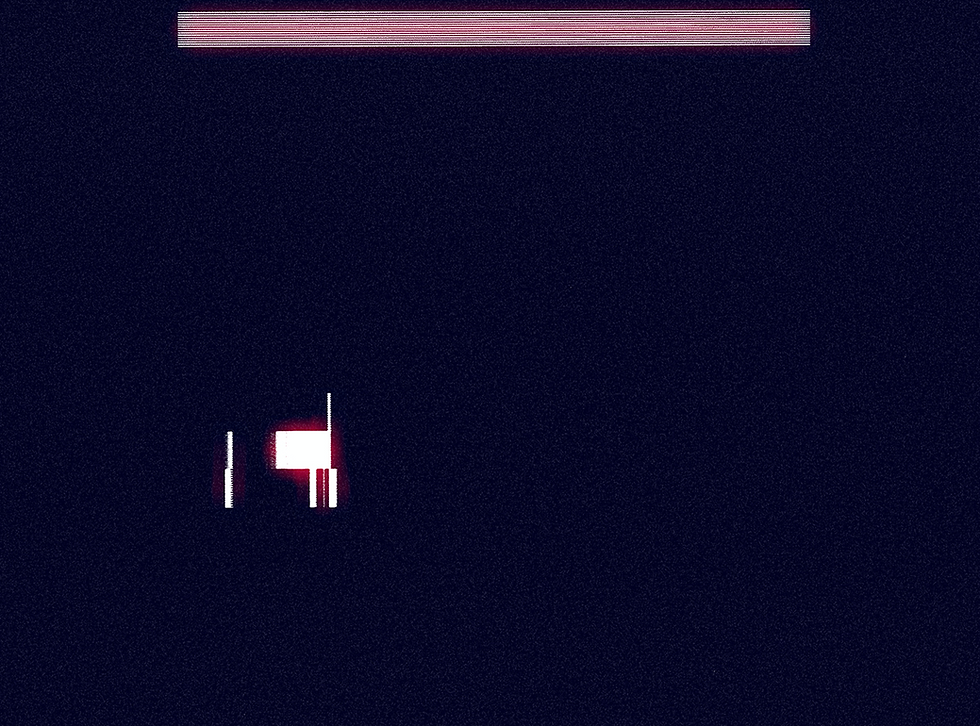Hybrid Soul | Mafe Izaguirre
- Mafe Izaguirre

- May 5, 2022
- 6 min read
Updated: Aug 29, 2023
Exploration of the Posthuman Soul through a Post-Poetic Machine in light of David Roden's Disconnection Thesis.
The Emotion Machine is a concept that frames a set of sentient artifacts that I am building to expand my human condition, specifically to develop better socio-technical capacities, and increase my emotional and cognitive dispositions in the face of imminent technological assimilation.
I conceive these devices as hybrid spiritual systems since they are wide entities constituted by a sum of technologies, as well as human, and nonhuman agents. The aesthetic experience is based on the reinterpretation of practices and rituals from my cultural heritage, which is deeply influenced by syncretism, shamanism, and animism. They are intended to explore non-symbolic workspaces and support non-linguistic forms of thinking.
My hybrid spiritual system is organized in serial layers. I involve a variety of media, materials, and agencies in assembling the tools I need to navigate these liminal spaces. All the instances are part of the same complex self-recursive ecosystem. I am referencing Roden's definition of Wide Descent, as a "technogenetic construction or 'assemblage' with both, narrowly humans and narrowly nonhumans parts" (Roden, p.5). So, I am building one wide machine, comparable to a "galaxy," made from many parts and entities whose relationship is "technically mediated to an arbitrary degree (Roden, p.6)." I am their human substrate but not the only agent involved. The devices, or "Sensitive Machines™" as I call them, are designed to maximize my capacities for deliberation and agency and to navigate the unknown dimensions of language as a plural body.
Video A | An Overview of The Sensitive Machine
Fragments of the Sensitive Machines have been exhibited in New York and South Dakota, USA.
The poetic machine I am presenting at this residency (see video B), visually manifests the residual content of language interchanged between human and nonhuman entities, hybrids, machines, and other systems. This is only possible with technological mediation. Among the voices represented, you will find a bird-man, whales, indigenous women, waves, machine noise, white noise, rain, and the jungle, to name a few. In terms of its functioning, the machine collects all these voices, discards the linguistic and symbolic content, and proposes a new inter-species lexicon that makes peripheral dynamics like resonances, echoes, rhythms, noises, and other patterns intelligible.
So far, the machine has produced more than 50 hybrid poems and keeps growing. Through this artifact, one can experience and feel the agency beyond space-time limits and language barriers. I am compiling these generative hybrid poems in a transmedia archive to promote awareness and reflection about diversity and posthuman agency. The work opens new possibilities to understand and bridge inter-species communication.
Video B | A glimpse of the post-poetic hybrid machine.
Inspired by Prof. Manuel Kretzer's sound visualization tutorials.
Hybrid Poems Archive
Displaying some of the hybrid poems.
Reflections on Non-symbolic Spaces
Archaeologist, art historian, and ethnologist, Ripinsky-Naxon (2) establishes the social importance of the shaman's skills as a catalyst for the culture-environment system:
"Equipped with an impressive corpus of empirical knowledge (etnoscience) and a profound grasp of human behavior, the shaman fulfills the vital role of a psychocultural adaptive mechanism, not merely as a healer of diseases, but as a harmonizer of social and natural dysfunctions and imbalance. In view of his ecological significance, the shaman's role as an agent in transcendental and existential realities tends to be underplayed by those who regard cultures as systems of more pragmatic and functional configurations. The importance of the latter two is undeniable in its own right; however, to de-emphasize symbolic (religious, spiritual, etc.) considerations is to fail in the understanding of the full integrative potential inherent to shamanism as a dynamic factor in the cultural process."
He also presents the relevance that symbolic imagery acquires within the system:
"The essence of sociocultural existence is centered around mythic imagery, which lends to human life an existential dimension. Pure, rational thought is no more an objective reality than the myths wherefrom such a concept is derived. Myths make up the fundamental responses to the basic human need for meaning. This need is an inescapable condition of human existence, pervading all areas of interactions: from techno-mechanical and sexual to highly symbolic and creative. In effect, myths often become cultural expressions for religious and ethical codes."
In my attempt to explore hybridization, I speculate on the idea that the machine serves as an autonomous cognitive system. The organism that is the machine, maps the environment while processing the information, and then returns to itself to represent what is perceived by producing a memory, in this case in the form of a poem. Peripheral devices involved, like software and hardware, act as a "nervous system" through which these machines obtain their capacity to react and reproduce adaptive relationships. In the case of the post-poetic machine, I center my attention on the relationship between voice and space. In the understanding that the voice is a body. In other cases, like the electronic installations, a symbiotic human-machine adaptation takes place, building what corresponds to a new reality. Still, the social agreement, which is the main objective to capture in cybernetics, occurs in human entities and not in the machine. This is the basis of my amplification proposal: I believe machines will become "smarter" and humans will become "wider" because our language will mutually adapt to these new functions. I also believe the machines will develop the ability to "feel" emotions independently. Their emotions will be machines' feelings, not humans' feelings. The understanding will happen in the correspondence we define as a resonance. In our case, this is how hybrid emotions are beginning to show and develop. New iterations of recursive improvements arise from conversational observations, so the hybrid entity we are —me, the machines, and the other bodies involved— expand, independently of how aware we are of this expansion.
The Disconnection Thesis Scheme
Inspired by David Roden's paper, lectures, and discussions presented during the residency I mapped a logic system that shows what is implied in the evolution from human to posthuman. The yellow boxes highlight the zones of Roden's thesis where my research is focused.

My Bio and Cultural Context
Fundamentally, I am interested in understanding what it means to be a human of our time. As a woman, I feel responsible for imagining and representing possible futures in which the female perspective is considered and actively integrated as a factor of reality. I am taking the creative risk of stressing my own limits and my audience's. My work demands my body as a subject, medium, tool, and substratum, and it requires complete dedication to the research and production processes. Creating the machine involves pushing my human limits to acquire new languages, experiences, skills, and knowledge. These machines are my attempt to amplify from human to posthuman, and in that attempt, I am aware I am pushing the posthuman emergence. Even in failure, I want to imprint my femininity into Roden's "wide human" consciousness.
Starting in the 1970s, the feminine assumed a conscious position in artistic and theoretical production associated with social and civic struggles for gender equality that continue to contribute to reinterpreting our historical reality. Feminist art has contributed enormously to recovering peripheral or marginalized expressive forms. The use of the female body at the hands of women has produced a psychological change in the way we approach femininity, not as an object but as a subject. Within this framework and in light of the posthuman condition, I use my body to delve into the psychological, philosophical, ethical, cultural, and political problems —to name a few— inherent to the technological assimilation and inter-species hybridization. As a Latinx, I integrate my cultural heritage to free the feminine from oblivion, shadow, and patriarchal oppression. The amplification of my body requires that my ethical commitment extends to the social, intellectual, and political body to which I belong. Aware of having chosen the most challenging path, I am convinced that my role and discourse provide essential values to the art scene to navigate the great questions we ask ourselves about identity and culture in the face of the singularity and the sixth extinction, more importantly when relevant topics such as spirituality and emotionality are still marginalized from the main conversation. Assuming that technological assimilation will allow us to survive, then women —in fact, everyone, especially minorities— must get involved in the definition and development of these technologies as critics and agents who conceive them and not only as consumers. We must pay special attention to language dynamics and the dominant tensions regarding using and distributing information as historical assets.
I come from a long line of Venezuelan kinetic artists. My interest in exploring color as a discursive resource is influenced by Master Carlos Cruz Diez. The civic sculptures of Master Alejandro Otero introduced me to the role of art as a tool for societal integration. My understanding and exploration of space have been deeply influenced by Gego's body of work. In 1972, Venezuelan artist María Zabala tackled projects in collaboration with the Venezuelan Institute for Scientific Research (IVIC), a development that culminated with her work on the computers of NYU between 1978 and 1980. She explored the concept of artificial memory to create a series of digital drawings and paintings. Among my contemporary influences is the Venezuelan artist Mariana Rondón, with her artificial wombs, four robots that conceive hybrid transgenic beings; Magdalena Fernandez with her exploration of resignifying space of meaning; poets Enrique Enriquez with his work on dadaist poetry and Eleonora Requena with her work on surrealist poetry; as well as the profound reflections of Stelarc's work. Today I can count myself among the 2% of Latin American women involved in the technology sector in the USA.
References:
(1) Minsky, Marvin. 2006. The Emotion Machine: Commonsense thinking, artifical intelligence, and the future of the human mind. First Edition. New York. Simon & Schuster Paperback.
(2) Ripinsky-Naxon, Michael. 1944. The Nature of Shamanism Substance and Function of a Religious Metaphor. New York. State University of New York Press.




















Comments